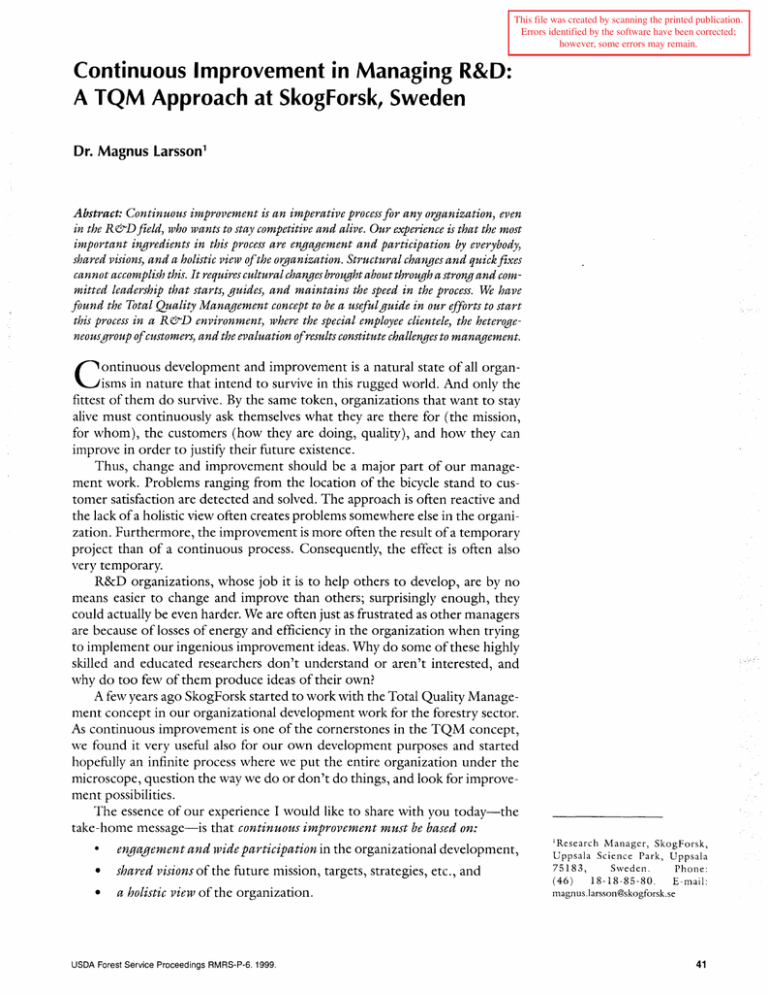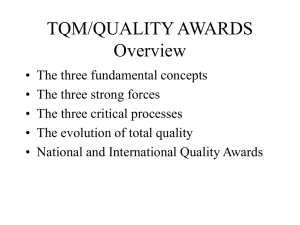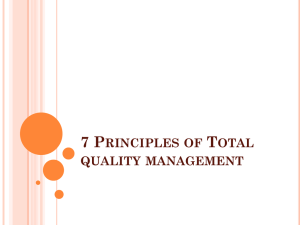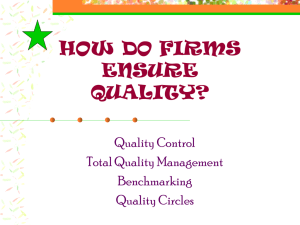Document 11871846
advertisement

This file was created by scanning the printed publication. Errors identified by the software have been corrected; however, some errors may remain. Continuous Improvement in Managing R&D: A TQM Approach at Skogforsk, Sweden Dr. Magnus Larsson 1 Abstract: Continuous improvement is an imperative process for any organization) even in the R&D field) who wants to stay competitive and alive. Our experience is that the most important ingredients in this process are engagement and participation by everybody) shared visions) and a holistic view ofthe organization. Structural changes and quick fixes cannot accomplish this. It requires cultural changes brought about through a strong and committed leadership that starts) guides) and maintains the speed in the process. We have found the Total Quality Management concept to be a useful guide in our efforts to start this process in a R&D environment) where the special employee clientele) the heterogeneousgroup ofcustomers) and the evaluation ofresults constitute challenges to management. C ontinuous development and improvement is a natural state of all organisms in nature that intend to survive in this rugged world. And only the fittest of them do survive. By the same token, organizations that want to stay alive must continuously ask themselves what they are there for (the mission, for whom), the customers (how they are doing, quality), and how they can improve in order to justify their future existence. Thus, change and improvement should be a major part of our management work. Problems ranging from the location of the bicycle stand to customer satisfaction are detected and solved. The approach is often reactive and the lack of a holistic view often creates problems somewhere else in the organization. Furthermore, the improvement is more often the result of a temporary project than of a continuous process. Consequently, the effect is often also very temporary. R&D organizations, whose job it is to help others to develop, are by no means easier to change and improve than others; surprisingly enough, they could actually be even harder. We are often just as frustrated as other managers are because of losses of energy and efficiency in the organization when trying to implement our ingenious improvement ideas. Why do some of these highly skilled and educated researchers don't understand or aren't interested, and why do too few of them produce ideas of their own? A few years ago SkogForsk started to work with the Total Quality Management concept in our organizational development work for the forestry sector. As continuous improvement is one of the cornerstones in the TQM concept, we found it very useful also for our own development purposes and started hopefully an infinite process where we put the entire organization under the microscope, question the way we do or don't do things, and look for improvement possibilities. The essence of our experience I would like to share with you today-the take- home message-is that continuous improvement must be based on: • engagement and wide participation in the organizational development, • shared visions of the future mission, targets, strategies, etc., and • a holistic view of the organization. USDA Forest Service Proceedings RMRS-P-6. 1999. 1 Research Manager, SkogForsk, Uppsala Science Park, Uppsala 75183, Sweden. Phone: (46) 18-18-85-80. E-mail: magn us .Iarsson @skogforsk.se 41 Continuous Improvement in Managing R&D: A TQM Approach Larsson Furthermore, this cannot be accomplished by structural changes and quick fixes. It requires cultural changes brought about through: committed leadership that trusts people's abilities, supports the improvement process itself, sets examples, and perhaps most importantly communicates, communicates, communicates (figure 1). I will start by briefly describing the process toward continuous improvement that we just have started at SkogForsk. Then I will reflect on what we have learned from the process so far and point at some of the pitfalls in change management that we have to be aware of so that this approach doesn't become another "shot in the dark" wherein the effects slowly fade away. Finally, I will make some personal reflections on how R&D organizations differ from others and in what ways TQM could help us overcome the obstacles ari_sing from these differences. • Figure 1-Some fundamentals of continuous improvement. A TQM Approach at SkogForsk Applied Research for the Forestry Sector From Seed Orchard to Mill SkogForsk-the Forestry Institute of Sweden-is sponsored by the entire forestry sector, i.e., the industrial forest enterprises, the private forest owners' cooperatives (Associations), other forestry organizations, and private individuals. Consequently, our primary target group (customers) comprises everybody working in practical forestry in Sweden. Our mission is to furnish Swedish forestry with the knowledge it requires to remain competitive and ecologically sustainable. We therefore work with applied research, which during the present program period focuses on four key issues: product value and production efficiency, forest management for biodiversity and timber production, organizational development, and regeneration material. We have some 115 employees, about 70 of whom are researchers and the remainder technicians and information and administration personnel (figure 2). A key concept at SkogForsk is collaboration with the forestry sector and other research bodies. Our research is organized in competence-oriented programs and problemoriented projects, each headed by a leader engaging 2-10 persons. A group comprising four research managers has the collective overall responsibility for the research work. The work program is developed and monitored in close 42 USDA Forest Service Proceedings RMRS-P-6. 1999. Continuous Improvement in Managing R&D: A TOM Approach Larsson cooperation with our members/ customers represented by the board and four advisory groups. The management of SkogForsk as a whole is the responsibility of the managing director, assisted by a management group comprising the four research managers, the managers of information and administration, and the heads of our three research stations. This is where the overall responsibility for continuous development of SkogForsk itself lies. The TQM Concept for Holistic View and Continuity Throughout the years we have worked with different kinds of organizational improvement activities: decentralization, research methods and skills, administrative processes, personnel competence, publication quality, and so on. With the exception of competence improvement, which we always have ORGANIZATION Figure 2-The organization of SkogForsk. regarded as a major strategic development area, the improvement work has been of quite a reactive and sporadic nature and a conscious holistic approach has not always been applied. A few years ago in our organizational development work for industry we became interested in the TQM concept (Thor et al. 1995 ). We are quite aware that this is just one of many management concepts around and it might not be the ultimate solution, but at this stage in our development we believe that TQM will serve our purposes. Why not live as we teach others? It has the holistic structure we were lacking and it encompasses continuity. TQM, as I assume most of you know, was developed in Japan after World War II by the Americans Deming and Juran. Their new thinking focused on: • the customers • the processes • engagement and participation by everybody • continuous improvement. But several other values are central, such as: committed leadership, competence development, long-range perspective, public responsibility, and learning from others (benchmarking). Thus, in TQM we focus on why and how we do things instead of only what the result is. That gives us a better base for improvement. USDA Forest Service Proceedings RMRS-P-6. 1999. 43 Larsson Continuous Improvement in Managing R&D: A TQM Approach The Implementation of TQM The TQM concept is a management philosophy/strategy-not a method. So in order to make it work we need a tool that makes us aware of how we run our business and the potential for improvement. The Swedish Quality Award is such a tool that is based primarily on the TQM values but also on other values and development concepts. The Swedish Quality Award (The Swedish Quality Award 1996), just like the Deming Price in Japan and the Malcolm Baldridge National Quality Award in the United States, requires a very detailed description of the organization and how it works. If you want to compete for the award you, of course, have to submit your description for evaluation. But you may just as well have it evaJuated for the sake of finding out where your improvement areas are and then go ahead with the actual improvement work. After a few years, when you may have run through this three-stage improvement cycle (description - evaluation improvement) a number of times, you may feel ready to compete for the award which often give the winners lots of publicity and goodwill. Even if you never win the Award, the process has taught you how you continuously work with improvement of the whole organization and hopefully the TQM core values will have been integrated in the organizational culture. The description is made by answering a set of questions that have been found relevant to successful organizations (figure 3). • The most important of these questions in the context of continuous improvement is: How do you evaluate and improve your work? Thus: • not only should you have methods and routines to set targets, to establish what your results are, to discover if they reached the target values, and to measure if they satisfy your customers, • you should also have established ways and means to continuously evaluate and improve these routines (the approaches) and how widely and frequently they are used (the deployment) in the organization. The questions are focused on seven main aspects (criteria) and a number of sub aspects of the organization to get the best possible picture of how it is working (figure 4). This takes care of the holistic thinking. Figure 3-The TQM questions. 44 USDA Forest Service Proceedings RMRS-P-6. 1999. Continuous Improvement in Managing R&D: A TQM Approach Larsson Figure 4-The TQM criteria. 4 Human Resources Development How We Started We felt the Swedish Quality Award procedure was very well structured and systematic and should serve our purposes. At the same time it would help us set a good example for the forestry sector we work for. So we began by describing our organization about one year ago, got it evaluated in May this year, and are just in the process of organizing and getting the first improvement activities started. The description was a rather heavy and time consuming effort resulting in a 70-page document. The work was initially done by the management group and in a final phase discussed and adjusted together with personnel from all parts of the organization. To get started we ourselves took part in seminars that we arranged for our members. The next phase in the process was the evaluation. This was done by an external consultant. We regarded the set of questions, some 200 of them, as a kind of checklist. Our answers to the questions revealed gaps and shortcomings in procedures and to what extent the TQM core values led our approaches, deployment, and results. The feedback report presented by the evaluator highlighted your strong points and potentials for improvement. Our strengths were management and strategic planning, whereas some of our weak points were the measurement of results and comparisons with others, which I am afraid we have in common with many other research organizations. This report now constitutes an excellent basis for the further planning of the improvement work. We picked out a few of what we felt were the most urgent areas for improvement. Working groups with wide participation were formed, targets were set, and the planning of the work was well on its way. Various tools and methods such as the PDCA cycle will be used. What We Have learned So Far Now come the interesting questions: What have we learned from the process so far and how do we keep the process going to avoid this becoming just another improvement project with temporary effects? USDA Forest Service Proceedings RMRS-P-6. 1999. 45 Continuous Improvement in Managing R&D: A TOM Approach Larsson Our Own Experience A strong and committed leadership is probably the most important ingredient in this process. Everybody in the top management must be convinced and agree that the strategy chosen is the way to go. The Managing Director must act as the process leader even if someone else may help out with the coordination of things. Every opportunity must be used to inform about what is going on, why, and how. Every formal as well as informal channel must be used: newsletters, meetings, coffee breaks, etc. And the signals from "above" must be strong and unanimous. Rese.archers are not always easy people to convince. You must have time and patience. This type of wide/holistic approach seems to take a lot of time. But if you try to add up all the effort you have spent on trying to implement improvements in less systematic ways with poor results, you probably will find that the systematic approach is worthwhile. You must give lots of time to the process itself and for the solutions to mature. Some General Experience - Pitfalls The overall cause for failures in organizational development is the underestimation of the need to manage change and to support the process itself (Sodergren 1997). Too often we start by focusing on the final solution. Many of us, being natural scientists, think we can just install a solution-while behavioral scientists know that it is primarily the mental processes of thinking and learning going on in human beings that we have to deal with in organizational development. To facilitate the further discussion on pitfalls in the management of change, I would like to point at some of the pulling and pushing forces that drive indivi duals and/or organizations to change. The pitfalls occur when one or more of these are too weak or neglected. Successful change managers know what triggers the forces and how their strengths are maintained (figure 5). Figure 5-Push i ng and pu IIi ng forces that drive individuals and organizations to change (Larsson 1998). pushing Meaning is probably the most important pulling force and very strong provided there is a vision of the future for the organization that the individual( s) can identify with. Individual visions should agree fairly well with that of the whole organization. 46 USDA Forest Service Proceedings RMRS-P-6. 1999. Continuous Improvement in Managing R&D: A TOM Approach Larsson Engagement develops and can become a real pushing incentive to change when the gap between the future vision and the present state is wide. If the present hurts, the engagement thus strengthens the meaning force. Motivation is another imperative pushing force. It is dependent on external remuneration variables such as salary, fringes, status, etc., and even more important internal emotional variables such as job satisfaction, trust, relations, self esteem, etc. Development opportunities for the individual and/or the entire organization as it moves from the present to the envisioned future is the other strong pulling force I'd like to bring up here. If the future has something in store for me and if this coincides reasonably well with my own interests, I am much more inclined to jump on the train than otherwise. However, in order to see the possibilities, the route between the present and the future vision (the development process) has to be mapped in terms of vision, mission, targets, strategies, plans, activities, and tasks. A holistic/systemic view on the organization required to do the job also needs to be taken. This means that the personnel, the tools/technique and methods, the control systems, and the organizational structure required to perform the tasks/processes must be described and communicated and the development needs for all of these systems components sorted out (Johanssen 1998) (figure 6). Figure 6-A holistic/systemic view of the organization where all components influence each other (Johansson 1988). The most common pitfalls in change management are: • lack of understanding of the need/urgency for change, which often stems from different or no opinions on the present state of affairs. It could also be that we cannot see any alternative for the future, i.e. we lack a common vision. If we do not agree on where we stand today or have a very vague idea of where to go, it is impossible to pick out a common route and go ahead. • lack of holistic/systemic view, where we observe the needs of the entire system and the links between the components. Fundamental needs may be neglected in favor of those that are easier to meet but do not get us much closer to our vision in the long run. Troubleshooting from the hip and ad hoc problem solving only generate temporary solutions. USDA Forest Service Proceedings RMRS-P-6. 1999. 47 Larsson Continuous Improvement in Managing R&D: A TQM Approach • lack of active and supportive management incorporating a united core group of management (guiding coalition) following, evaluating, communicating, and even celebrating the achievements. Great things may be accomplished if you keep looking for them. • lack of continuity often due to a combination of the above and very limited engagement/participation of personnel. Continuous improvement must be founded on strong leadership, holistic approach, shared values and visions, and a constant watch by everybody in the organization for ways to do things even better than now. Personal Reflections on Specifics of R&D. Organizations Naturally there are numerous reasons why change in general and continuous change in particular may be more difficult to implement in a R&D organization than in others. Moreover, because of the great variety of organizations within our field of work, it is very difficult to make too many general reflections here. I will therefore confine myself to the three factors that, from my limited SkogForsk perspective, seem to make life challenging for managers of change in the research field: the employee clientele, the customer profile, and the evaluarion of results. Researchers Are Very Special People The first factor is the special employee clientele we are dealing with. Even if they are very open-minded by nature, they are often individualists and don't buy ideas or arguments without having given them many thorough thoughts. In spite ofbeing a very heterogeneous bunch, most of them are well educated, committed, used to questioning matters, systematic, and not impressed by authorities such as managers. Many of them are even so devoted to their job within the program/project that they may have little faith in the necessity of management improvements in the first place (figure 7). There may also be another reason for the lack of interest in organizational matters. A research organization is often rather fragmented in comparison to, for example, a production company. There is no obvious chain/line of operations/processes resulting in products yielding immediate revenues. Departments, Active Figure 7-Researchers' learning styles are probably more reflective and analytical than those of the practitioners (Honey and Mumford 1982). Analytic/ Logical 48 USDA Forest Service Proceedings RMRS-P-6. 1999. '_,·:. Continuous Improvement in Managing R&D: A TOM Approach Larsson programs, or projects usually work fairly independent of each other with no traditional line responsibility. Consequently, a project leader is not used to the helicopter perspective of the organization and may have some trouble seeing the benefits of this holistic, continuous approach. What all this probably boils down to is that researchers learn and are influenced in other ways than people with more operative/practical jobs. We, the researchers, need models and proven or reliable theories presented by trusted colleagues whereas others may just try something and learn from their actions, as in the trial and error approach. The conceivable implication of this is that much effort has to be devoted to the consensus of the need and direction of change. I believe that an accepted concept such as TQM can facilitate continuity in the improvement process, provided that we can establish efficient forms for communicating and agreeing on our visions and mission, set realistic targets, and together agree on common responsibility and methods to monitor and improve our approaches and results. This naturally calls for strong leadership. Here I may add that the individuals in management groups of research organizations very often have a research background themselves-with basically the same characteristics as the rest of the pack. So before everything else it is of utmost importance to have thorough discussions within this group in order to share the values and visions and really get every single member to agree on targets and courses of action. Heterogeneous Group of Customers The other factor that may be specific to research organizations is the customer profile. We are to serve an entire Industry Sector with knowledge. This may be a bother especially for applied- or problem-oriented research organizations, such as SkogForsk and FERIC, where both short- and long-term practical problems are to be solved for a very heterogeneous group of customers who also happens to be our members/owners. The problem here is how we can arrive at a common vision of roles and procedures together with small and geographically widespread companies and individual operators with very different, if any, visions of their own and very diversified opinions of what the most urgent research needs are. Also here I believe that TQM can serve as a guide when it comes to customer orientation and the continuous contacts and communication embedded in the organization for that purpose. Difficult to Evaluate the Results The third and last factor I'd like to bring up here is the evaluation ofresults. There are ways to quantifY the end value to the customer of some of our work. We have tried cost-benefit analyses, especially in very applied, short-term areas such as technical development. Other areas such as growth models are more difficult to evaluate. How do you evaluate their reliability? The only way out here as I see it is, again, communication with the customer from the initiation of the project through the final dissemination of results. The other aspect of this evaluation is the efficiency of the work itself, which is a result of competence, organization, tools, etc. Here, close monitoring and comparison with others (benchmarking), which now are being discussed on both national and international levels, should help. USDA Forest Service Proceedings RMRS-P-6. 1999. 49 Continuous Improvement in Managing R&D: A TOM Approach Larsson Summary: How We Intend to Safeguard Continuous Improvement in Managing Skogforsk An organizational culture and management strategy based on the TQM core values, whose central features include: • committed and unanimous leadership; • wide engagement and participation, based on trust in each individual and common visions for the future; • continuous watch for management improvement possibilities by builtin evaluation of results and approaches in all aspects of the organization (holistic view); and • close customer/member contacts. References Honey, Peter and Mumford, Alan, The Manual of Learning Styles. Peter Honey, Management Consultant, Maidenhead, England, 1982. Johansson, Jan, Or;ganization Diagnosis, Synapses AB. Maglehem, Sweden, 1988. Larsson, Peter, Arbetskonsulter AB (Swedish management consultant), 1998. Sodergren, Birgitta, Pa viig mot en horisontell or;ganisation? EFI, Handelshogskolan, Stockholm, 1997. The Swedish Quality Award 1996, Guidelines- A Tool for the Development of Or;ganizations. The Swedish Institute for Quality, 1996. Thor, Gunilla & Skuttin, Sten-Gunnar, Total Quality Management in Forestry. SkogForsk, Redogorelse nr 5, 1995. 50 USDA Forest Service Proceedings RMRS-P-6. 1999.




